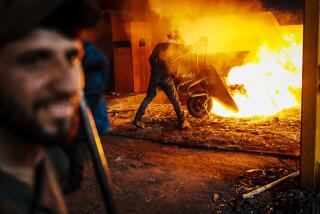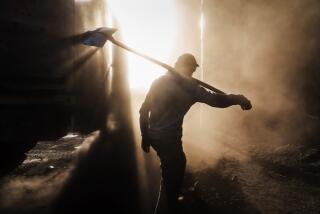Afghanistan Hangs on a Thread
- Share via
With the United States preoccupied with Iraq, the fate of its previous object of liberation -- Afghanistan -- hangs precariously in the balance.
Defense Secretary Donald Rumsfeld arrived in Kabul this month to signal a shift in American priorities from “major combat” to “stability.” But within days of his announcement, multiple guerrilla attacks forced the United Nations to suspend mine-clearing operations. Increasingly bold and frequent strikes by opponents of Hamid Karzai’s government have since targeted Afghan and U.S. and other foreign soldiers. On Saturday, American warplanes engaged Taliban troops after a deadly ambush near Khost.
Eighteen months after the fall of the Taliban regime, the threat of renewed mass violence haunts Afghanistan. Veteran moujahedeen like Gulbuddin Hekmatyar have declared war against the U.S.-backed government. Taliban leaders have also resurfaced, backed by supporters in Pakistan. These fighters and their foreign sponsors bear responsibility for jeopardizing the gains of the post-Taliban era. But they are not alone.
A flawed reconstruction plan is perpetuating this insecurity, destabilizing the region and undermining the U.S. anti-terrorism campaign. Instability stems from the manner in which the government was formed.
The U.S. wagered the stability of the nation on Karzai, a Pashtun, and his Tajik rivals from a small region north of the capital. In a reversal of two centuries of Afghan history, power now resides not with rulers from Pashtun tribes, with the exception of Karzai, but with a narrow Tajik elite that controls the ministries of defense, intelligence and foreign affairs.
Ignored outside Kabul, the president rarely appears in the capital. The U.S. blames Karzai’s isolation on regional warlords and is pressing him to move against them, hinting that U.S. forces may assist him.
However, these charges conceal a more complex story behind Karzai’s weakness. Although the U.S. secured a loyal executive in Karzai, it failed to forge a coalition broad enough to integrate Afghanistan’s varied regions. With 200,000 men under arms (some provided by the U.S. for operations against Al Qaeda), local commanders now have little incentive to cooperate. Enriched by control of the drug trade and customs duties, they oppose demobilization.
Afghanistan’s past also makes these commanders wary of surrendering their autonomy. Pashtun governments have long used a heavy hand to impose their will. Hazara, Uzbek and other tribal or ethnic communities remain anxious about a national army, which previous regimes used to bully various groups. These communities nervously await a new constitution to see whether it provides for federalism and equality between Sunnis and Shiites.
The scarcity of reconstruction aid contributes to this warlordism. Although the national army, which pays its members just $30 a month, must struggle to keep even half its recruits, militias thrive. Herat Gov. Ismail Khan supports 40,000 soldiers and a solid infrastructure. Until real aid arrives, Afghans will keep their AK-47 rifles. And without funding for crop substitution, farmers will preserve the country’s status as the world’s leading opium producer.
Action against Khan and other regional elites won’t solve the problems that sap the legitimacy of Karzai’s government. For one thing, the government was never equipped to address the humanitarian crisis, or even to provide the capital with a steady flow of electricity. Half a million are internally displaced. Only 20% of the population has clean water. Land mines kill 100 villagers and injure 500 monthly.
Although a new reconstruction plan promises $200 for every family, many will not see this money for three years. The Pentagon’s Provincial Reconstruction Teams are operating in only three of 32 provinces.
The interim government faces a growing number of critics. Human rights groups, long critical of the warlords, have charged members of Karzai’s government with threatening journalists and expelling Pashtuns from the north. Other officials stand accused of nepotism. In Kabul, protesters denounce the government and the U.S.
Disillusioned Afghans now cast doubt on American plans for the establishment of a democratic government representative of this diverse society -- the very matrix of the U.S. vision for Iraq. The fortunes of the anti-terrorism campaign are tied to Karzai’s narrow base.
American policymakers suggest that U.S. troops may withdraw next year, when elections are scheduled to take place. Yet they have not created a mechanism to hold neighboring states accountable for pursuing their rivalries at the expense of Afghanistan. Without such an international agreement, improvements in the security and humanitarian situation and meaningful incentives and guarantees for broader power-sharing, a wider war threatens the region. Afghanistan and its neighbors must be pulled from the brink and their lessons learned for Iraq.
More to Read
Sign up for Essential California
The most important California stories and recommendations in your inbox every morning.
You may occasionally receive promotional content from the Los Angeles Times.












